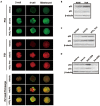CFTR mediates bicarbonate-dependent activation of miR-125b in preimplantation embryo development
- PMID: 22664907
- PMCID: PMC3463266
- DOI: 10.1038/cr.2012.88
CFTR mediates bicarbonate-dependent activation of miR-125b in preimplantation embryo development
Abstract
Although HCO(3)(-) is known to be required for early embryo development, its exact role remains elusive. Here we report that HCO(3)(-) acts as an environmental cue in regulating miR-125b expression through CFTR-mediated influx during preimplantation embryo development. The results show that the effect of HCO(3)(-) on preimplantation embryo development can be suppressed by interfering the function of a HCO(3)(-)-conducting channel, CFTR, by a specific inhibitor or gene knockout. Removal of extracellular HCO(3)(-) or inhibition of CFTR reduces miR-125b expression in 2 cell-stage mouse embryos. Knockdown of miR-125b mimics the effect of HCO(3)(-) removal and CFTR inhibition, while injection of miR-125b precursor reverses it. Downregulation of miR-125b upregulates p53 cascade in both human and mouse embryos. The activation of miR-125b is shown to be mediated by sAC/PKA-dependent nuclear shuttling of NF-κB. These results have revealed a critical role of CFTR in signal transduction linking the environmental HCO(3)(-) to activation of miR-125b during preimplantation embryo development and indicated the importance of ion channels in regulation of miRNAs.
Figures






Similar articles
-
Novel role for pendrin in orchestrating bicarbonate secretion in cystic fibrosis transmembrane conductance regulator (CFTR)-expressing airway serous cells.J Biol Chem. 2011 Nov 25;286(47):41069-82. doi: 10.1074/jbc.M111.266734. Epub 2011 Sep 13. J Biol Chem. 2011. PMID: 21914796 Free PMC article.
-
Involvement of Cl(-)/HCO3(-) exchanger SLC26A3 and SLC26A6 in preimplantation embryo cleavage.Sci Rep. 2016 Jun 27;6:28402. doi: 10.1038/srep28402. Sci Rep. 2016. PMID: 27346053 Free PMC article.
-
Intestinal bicarbonate secretion in cystic fibrosis mice.JOP. 2001 Jul;2(4 Suppl):263-7. JOP. 2001. PMID: 11875269
-
Functional interactions of HCO3- with cystic fibrosis transmembrane conductance regulator.JOP. 2001 Jul;2(4 Suppl):207-11. JOP. 2001. PMID: 11875261 Review.
-
Selective activation of cystic fibrosis transmembrane conductance regulator Cl- and HCO3- conductances.JOP. 2001 Jul;2(4 Suppl):212-8. JOP. 2001. PMID: 11875262 Review.
Cited by
-
CFTR-β-catenin interaction regulates mouse embryonic stem cell differentiation and embryonic development.Cell Death Differ. 2017 Jan;24(1):98-110. doi: 10.1038/cdd.2016.118. Epub 2016 Nov 11. Cell Death Differ. 2017. PMID: 27834953 Free PMC article.
-
Upregulation of CFTR in patients with endometriosis and its involvement in NFκB-uPAR dependent cell migration.Oncotarget. 2017 Mar 22;8(40):66951-66959. doi: 10.18632/oncotarget.16441. eCollection 2017 Sep 15. Oncotarget. 2017. PMID: 28978008 Free PMC article.
-
Functional Significance of the Adcy10-Dependent Intracellular cAMP Compartments.J Cardiovasc Dev Dis. 2018 May 11;5(2):29. doi: 10.3390/jcdd5020029. J Cardiovasc Dev Dis. 2018. PMID: 29751653 Free PMC article. Review.
-
NBCe1 Regulates Odontogenic Differentiation of Human Dental Pulp Stem Cells via NF-κB.Int J Stem Cells. 2022 Nov 30;15(4):384-394. doi: 10.15283/ijsc21240. Epub 2022 Jun 30. Int J Stem Cells. 2022. PMID: 35769055 Free PMC article.
-
What Role Does CFTR Play in Development, Differentiation, Regeneration and Cancer?Int J Mol Sci. 2020 Apr 29;21(9):3133. doi: 10.3390/ijms21093133. Int J Mol Sci. 2020. PMID: 32365523 Free PMC article. Review.
References
-
- Maas DH, Storey BT, Mastroianni L., Jr Hydrogen ion and carbon dioxide content of the oviductal fluid of the rhesus monkey (Macaca mulatta) Fertil Steril. 1977;28:981–985. - PubMed
-
- Murdoch RN, White IG. The influence of the female genital tract on the metabolism of rabbit spermatozoa. I. Direct effect of tubal and uterine fluids, bicarbonate, and other factors. Aust J Biol Sci. 1968;21:961–972. - PubMed
-
- Vishwakarma P. The pH and bicarbonate-ion content of the oviduct and uterine fluids. Fertil Steril. 1962;13:481–485. - PubMed
-
- Ali J, Whitten WK, Shelton JN. Effect of culture systems on mouse early embryo development. Hum Reprod. 1993;8:1110–1114. - PubMed
-
- Chen MH, Chen H, Zhou Z, et al. Involvement of CFTR in oviductal HCO3- secretion and its effect on soluble adenylate cyclase-dependent early embryo development. Hum Reprod. 2010;25:1744–1754. - PubMed
Publication types
MeSH terms
Substances
LinkOut - more resources
Full Text Sources
Molecular Biology Databases
Research Materials
Miscellaneous

